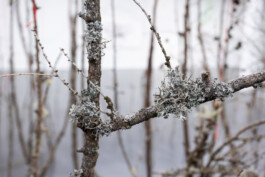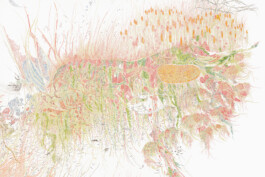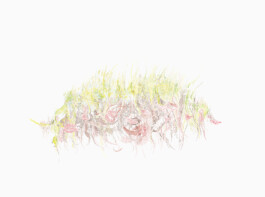A Piece of (Wild) Life








A Piece of (Wild) Life, installation view Kubus. Sparda-Kunstpreis at the Kunstmuseum Stuttgart, 2024; Photo: Gerald Ulmann
A Piece of (Wild) Life, installation view Kubus. Sparda-Kunstpreis at the Kunstmuseum Stuttgart, 2024; Photo: Gerald Ulmann
A Piece of (Wild) Life, installation view Kubus. Sparda-Kunstpreis at the Kunstmuseum Stuttgart, 2024; Photo: Gerald Ulmann
A Piece of (Wild) Life, installation view Kubus. Sparda-Kunstpreis at the Kunstmuseum Stuttgart, 2024; Photo: Gerald Ulmann
A Piece of (Wild) Life, installation view Kubus. Sparda-Kunstpreis at the Kunstmuseum Stuttgart, 2024; Photo: Gerald Ulmann
A Piece of (Wild) Life, installation view Kubus. Sparda-Kunstpreis at the Kunstmuseum Stuttgart, 2024; Photo: Gerald Ulmann
A Piece of (Wild) Life, installation view Kubus. Sparda-Kunstpreis at the Kunstmuseum Stuttgart, 2024; Photo: Gerald Ulmann
A Piece of (Wild) Life, installation view Kubus. Sparda-Kunstpreis at the Kunstmuseum Stuttgart, 2024; Photo: Gerald Ulmann
Luminous colour particles of felt-tip pen, coloured pencil and watercolour are condensed in the delicate drawings by Gabriela Oberkofler (*1975 Bolzano, South Tyrol). Animals and plants inhabit the pictorial worlds, whose shapes are made up of small lines and dots. At the Kunstmuseum Stuttgart, the artist presents her drawings in different ways: framed behind glass, printed on a wallpaper or, in a complex process lasting several days, drawn directly onto the wall of the museum.
Oberkofler combines her drawings of flora and fauna with organic material. The floor of the room is covered with carvings and a glass vessel in which moss grows: a small ecosystem of its own. In the centre of the room, an extensive forest of dead wood blocks the unobstructed view through the room. Red cords hold the natural set pieces in an upright position. The forest—a walk-in spatial ensemble—appears revitalised.
Oberkofler draws attention to the beauty of ecosystems and the threats they face. She describes her approach, which has run through her work for some time now, as reconciliation—an apt term for her artistic practice, in which she sees herself as a mediator between man and nature. Oberkofler combines the upright pieces of wood with small-format drawings that depict utopian conditions. Animals and plants coexist in these pictorial worlds in ecosystems that are not actually related: A fire salamander shares the picture surface with a wolf cat and meadow grasses and a brown trout lives next to mosses. The artist understands these drawings in terms of a cause-and-effect relationship in which man and nature are mutually dependent. Her drawing is a form of observation. A humorous exaggeration on the playground of her world of thought, in which she reflects on the network of relationships between man and nature.
Oberkofler combines her artistic practice with a scientific approach: in 2022, she founded the ‘Institut für alternative Landwirtschaft’ on her farm in South Tyrol, which currently houses a seed archive of over 470 plant varieties. Oberkofler sees this so-called ‘Weltgarten’ as a world that is growing together and overcoming borders. Her aim is to understand growth processes and the coexistence of plants and other living organisms in mixed cultures.
Booklet for the exhibition Kubus. Sparda-Kunstpreis 2024 at the Kunstmuseum Stuttgart

Detail Mooszooms, 2023, ink and watercolour on paper, 130 × 260 cm

Detail Mooszooms, 2023, ink and watercolour on paper, 130 × 260 cm

Mooszooms, 2023, ink and watercolour on paper, 130 × 260 cm





A Piece of (Wild) Life, installation view Kubus. Sparda-Kunstpreis at the Kunstmuseum Stuttgart, 2024; Photo: Gerald Ulmann
A Piece of (Wild) Life, installation view Kubus. Sparda-Kunstpreis at the Kunstmuseum Stuttgart, 2024; Photo: Gerald Ulmann
A Piece of (Wild) Life, installation view Kubus. Sparda-Kunstpreis at the Kunstmuseum Stuttgart, 2024; Photo: Gerald Ulmann
A Piece of (Wild) Life, installation view Kubus. Sparda-Kunstpreis at the Kunstmuseum Stuttgart, 2024; Photo: Gerald Ulmann
A Piece of (Wild) Life, installation view Kubus. Sparda-Kunstpreis at the Kunstmuseum Stuttgart, 2024; Photo: Gerald Ulmann










Finger from the series Verkettungen, 2024, 10 drawings, watercolour on paper, 80 × 70 cm
Herz from the series Verkettungen, 2024, 10 drawings, watercolour on paper, 80 × 70 cm
Karpfen from the series Verkettungen, 2024, 10 drawings, watercolour on paper, 80 × 70 cm
Mensch from the series Verkettungen, 2024, 10 drawings, watercolour on paper, 80 × 70 cm
Pusteblume from the series Verkettungen, 2024, 10 drawings, watercolour on paper, 80 × 70 cm
Salamander from the series Verkettungen, 2024, 10 drawings, watercolour on paper, 80 × 70 cm
Seepferdchen from the series Verkettungen, 2024, 10 drawings, watercolour on paper, 80 × 70 cm
Totenkopf from the series Verkettungen, 2024, 10 drawings, watercolour on paper, 80 × 70 cm
Wiesenblumen from the series Verkettungen, 2024, 10 drawings, watercolour on paper, 80 × 70 cm
Wilde Orchidee from the series Verkettungen, 2024, 10 drawings, watercolour on paper, 80 × 70 cm
A Piece of (Wild) Life








A Piece of (Wild) Life, installation view Kubus. Sparda-Kunstpreis at the Kunstmuseum Stuttgart, 2024; Photo: Gerald Ulmann
A Piece of (Wild) Life, installation view Kubus. Sparda-Kunstpreis at the Kunstmuseum Stuttgart, 2024; Photo: Gerald Ulmann
A Piece of (Wild) Life, installation view Kubus. Sparda-Kunstpreis at the Kunstmuseum Stuttgart, 2024; Photo: Gerald Ulmann
A Piece of (Wild) Life, installation view Kubus. Sparda-Kunstpreis at the Kunstmuseum Stuttgart, 2024; Photo: Gerald Ulmann
A Piece of (Wild) Life, installation view Kubus. Sparda-Kunstpreis at the Kunstmuseum Stuttgart, 2024; Photo: Gerald Ulmann
A Piece of (Wild) Life, installation view Kubus. Sparda-Kunstpreis at the Kunstmuseum Stuttgart, 2024; Photo: Gerald Ulmann
A Piece of (Wild) Life, installation view Kubus. Sparda-Kunstpreis at the Kunstmuseum Stuttgart, 2024; Photo: Gerald Ulmann
A Piece of (Wild) Life, installation view Kubus. Sparda-Kunstpreis at the Kunstmuseum Stuttgart, 2024; Photo: Gerald Ulmann
Luminous colour particles of felt-tip pen, coloured pencil and watercolour are condensed in the delicate drawings by Gabriela Oberkofler (*1975 Bolzano, South Tyrol). Animals and plants inhabit the pictorial worlds, whose shapes are made up of small lines and dots. At the Kunstmuseum Stuttgart, the artist presents her drawings in different ways: framed behind glass, printed on a wallpaper or, in a complex process lasting several days, drawn directly onto the wall of the museum.
Oberkofler combines her drawings of flora and fauna with organic material. The floor of the room is covered with carvings and a glass vessel in which moss grows: a small ecosystem of its own. In the centre of the room, an extensive forest of dead wood blocks the unobstructed view through the room. Red cords hold the natural set pieces in an upright position. The forest—a walk-in spatial ensemble—appears revitalised.
Oberkofler draws attention to the beauty of ecosystems and the threats they face. She describes her approach, which has run through her work for some time now, as reconciliation—an apt term for her artistic practice, in which she sees herself as a mediator between man and nature. Oberkofler combines the upright pieces of wood with small-format drawings that depict utopian conditions. Animals and plants coexist in these pictorial worlds in ecosystems that are not actually related: A fire salamander shares the picture surface with a wolf cat and meadow grasses and a brown trout lives next to mosses. The artist understands these drawings in terms of a cause-and-effect relationship in which man and nature are mutually dependent. Her drawing is a form of observation. A humorous exaggeration on the playground of her world of thought, in which she reflects on the network of relationships between man and nature.
Oberkofler combines her artistic practice with a scientific approach: in 2022, she founded the ‘Institut für alternative Landwirtschaft’ on her farm in South Tyrol, which currently houses a seed archive of over 470 plant varieties. Oberkofler sees this so-called ‘Weltgarten’ as a world that is growing together and overcoming borders. Her aim is to understand growth processes and the coexistence of plants and other living organisms in mixed cultures.
Booklet for the exhibition Kubus. Sparda-Kunstpreis 2024 at the Kunstmuseum Stuttgart

Detail Mooszooms, 2023, ink and watercolour on paper, 130 × 260 cm

Detail Mooszooms, 2023, ink and watercolour on paper, 130 × 260 cm

Mooszooms, 2023, ink and watercolour on paper, 130 × 260 cm





A Piece of (Wild) Life, installation view Kubus. Sparda-Kunstpreis at the Kunstmuseum Stuttgart, 2024; Photo: Gerald Ulmann
A Piece of (Wild) Life, installation view Kubus. Sparda-Kunstpreis at the Kunstmuseum Stuttgart, 2024; Photo: Gerald Ulmann
A Piece of (Wild) Life, installation view Kubus. Sparda-Kunstpreis at the Kunstmuseum Stuttgart, 2024; Photo: Gerald Ulmann
A Piece of (Wild) Life, installation view Kubus. Sparda-Kunstpreis at the Kunstmuseum Stuttgart, 2024; Photo: Gerald Ulmann
A Piece of (Wild) Life, installation view Kubus. Sparda-Kunstpreis at the Kunstmuseum Stuttgart, 2024; Photo: Gerald Ulmann










Finger from the series Verkettungen, 2024, 10 drawings, watercolour on paper, 80 × 70 cm
Herz from the series Verkettungen, 2024, 10 drawings, watercolour on paper, 80 × 70 cm
Karpfen from the series Verkettungen, 2024, 10 drawings, watercolour on paper, 80 × 70 cm
Mensch from the series Verkettungen, 2024, 10 drawings, watercolour on paper, 80 × 70 cm
Pusteblume from the series Verkettungen, 2024, 10 drawings, watercolour on paper, 80 × 70 cm
Salamander from the series Verkettungen, 2024, 10 drawings, watercolour on paper, 80 × 70 cm
Seepferdchen from the series Verkettungen, 2024, 10 drawings, watercolour on paper, 80 × 70 cm
Totenkopf from the series Verkettungen, 2024, 10 drawings, watercolour on paper, 80 × 70 cm
Wiesenblumen from the series Verkettungen, 2024, 10 drawings, watercolour on paper, 80 × 70 cm
Wilde Orchidee from the series Verkettungen, 2024, 10 drawings, watercolour on paper, 80 × 70 cm